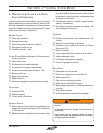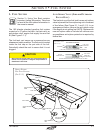
3.5192 Islander
®
seCtIon 3 • usIng your Boat
Bring the shift/throttle lever
back to neutral position. The
THROTTLE ONLY button will
pop out.
Then move the shift/throttle
lever rapidly, either forward or
reverse, but not very far from
the neutral position. The drive
unit will engage and boat will
start to move slowly in either
forward or reverse. You can
damage the transmission if you
do not shift quickly from neutral
into gear. Once clear of the dock, mooring, people,
and/or the no-wake zone, and the boat has been
shifted into forward gear, move shift/throttle lever
forward to desired engine speed.
WARM ENGINE - Press THROTTLE ONLY
button and move shift/throttle lever about 1/4
open throttle position. Do not pump lever.
FLOODED ENGINE - Press THROTTLE ONLY
button and move shift/throttle lever to full open
position. DO NOT pump lever. When the engine
starts, move shift/throttle lever back rapidly to
decrease engine speed to between 1000 and
1500 RPM.
7. TO START ENGINE:
Turn ignition keys clockwise,
as you would an automobile,
and release when engine
starts. Do not crank engine for
more than a few seconds if it
doesn’t start. Engine may be
very cold or ooded; see step
6.
8. After engine starts, reduce speed to between
1000 and 1500 RPM and check oil pressure.
9. If oil pressure is correct, let
engine warm up to normal
temperature range as specied
in the engine manual, before
shifting into forward or reverse
gear.
IF ENGINE TEMPERATURE
GOES ABOVE NORMAL
RANGE. SHUT DOWN THE
ENGINE IMMEDIATELY. GET
TRAINED HELP TO FIND
AND FIX THE PROBLEM.
IF OIL PRESSURE GOES ABOVE OR BELOW
OPERATING RANGE, SHUT ENGINE DOWN
IMMEDIATELY. GET TRAINED HELP TO FIND
AND FIX THE PROBLEM.
8. shifTinG To Drive The boaT
100 220
170
T E M P
F /C
55 80
130
(FIg. 3.5.3)
!
CAUTION
Cockpit can fill with water if boat is moving
forward, when it is put into reverse.
Before shifting into reverse, shift to neutral, wait
for the boat to stop moving forward, then shift
into reverse.
(FIg 3.5.5)
(FIg 3.5.4)
(FIg. 3.5.2)
0
0 80
40
OIL
psi/kPa
250
500
(FIg. 3.5.1)


















